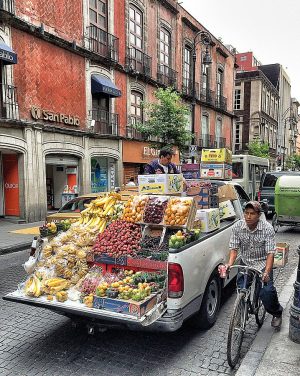Amid the noisy bustle of Mexico City, there is one iconic sound echoing on repeat in the background. A recording that blares from trucks looking to buy old household items and appliances, either to fix and resell or to sell for scrap. The crews inside these trucks are essentially scrap metal haulers and the recording is their pitch to prospective sellers. It lists out all the household castoffs they’re looking to purchase (mattresses, bed frames…) and then crescendos gloriously with this line: “…o algo de fierro viejo que vendan!” which basically means “…or any old metal thing you’re selling!” This last bit has become the recording’s namesake: fierro viejo, literally “old iron.”
The recording started popping up in neighborhoods surrounding the capital city in the early 2000’s. One of Mexico’s major newspapers referred to it as the most popular sound in all of Mexico. However, fierro viejo is just one voice in a cacophony of street selling in Mexico City. To grab customers’ attention in the middle of all the commotion street vendors use pregones.
Pregones have an element of performance to them. They draw attention to the vendor’s products by utilizing distinctive intonations, cadences, and often clever turns of phrase. It’s not an accident that time and again pregones have found their way into popular culture. While the fierro viejo recording fits squarely into Mexico’s rich tradition of pregones, it’s also a stark departure from it. That has everything to do with the voice that delivers it.
 To get the story behind this iconic recording, producer Ted Siefer met Marco Antonio Terron and his family on the outskirts of Mexico City. When Marco first started collecting scrap metal he would beckon sellers by shouting through a cardboard megaphone. One day, Marco had an idea: He would make a recording of his pitch, that way he wouldn’t have to strain his vocal cords for hours on end. But Marco felt his own voice was too low and gravely, and so he turned to his nine-year-old daughter for help.
To get the story behind this iconic recording, producer Ted Siefer met Marco Antonio Terron and his family on the outskirts of Mexico City. When Marco first started collecting scrap metal he would beckon sellers by shouting through a cardboard megaphone. One day, Marco had an idea: He would make a recording of his pitch, that way he wouldn’t have to strain his vocal cords for hours on end. But Marco felt his own voice was too low and gravely, and so he turned to his nine-year-old daughter for help.
Marimar Terron Martinez, who’s now 28, is known as the original voice of fierro viejo. She’s active on social media, under the names “la voz del fierro viejo” and “niña del hierro” – literally girl of iron. Social media has helped Marimar and fierro viejo gain international fame. Versions of the pregon have been posted in other languages on TikTok and Instagram.
Pregones have a certain undeniable charm, but there is a harsher reality behind them. They remain common because many street vendors in Mexico and other parts of Latin America can’t find decent jobs. More than 50 percent of residents in Mexico City work in the informal economy. In a metropolitan area with 22 million, that’s a workforce of millions going out everyday, from mariachi bands to scrap metal haulers. You might wonder why the government would tolerate street selling at such a scale. The short answer is they don’t really have a choice.
Technically, street selling is banned in certain sections of the city, including parts of the historic center – areas that are often packed with vendors. The ways in which restrictions are actually enforced often comes down to political expediency. This leaves a huge gray area, governed by unspoken codes and occasionally bribes.
As parts of Mexico City become more gentrified, there are signs the tolerance may be wearing thin. The mayor of the section of Mexico City that includes some of its tonier districts recently pushed through a policy requiring all food vending stalls to have uniform signs, with the city seal. This effectively did away with a long, rich tradition of colorful hand-painted stalls.
The city has also recently enacted noise pollution rules. While primarily aimed at construction sites and industrial businesses, it also applies to vehicles and trucks blasting fierro viejo would very likely exceed the 68-decibel limit. So far, no one seems to be getting tickets, but the days of blasting out fierro viejo and other such calls may be numbered.



Leave a Comment
Share